Contents
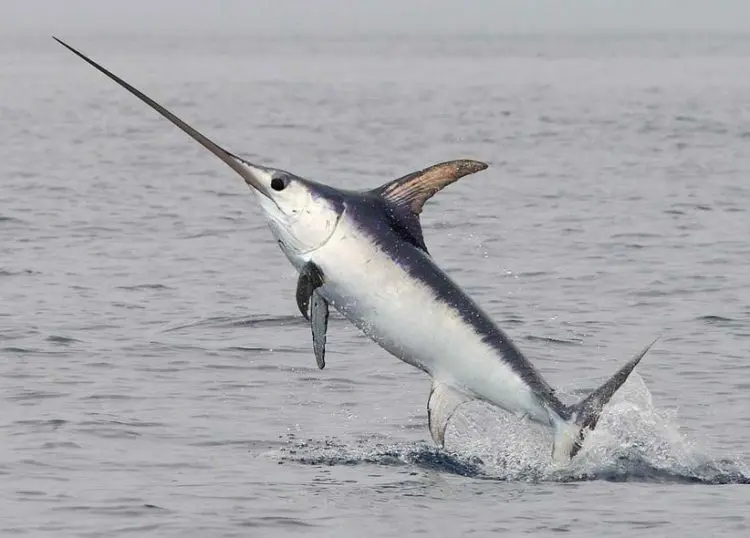
This fish is also called the swordfish (Xiphias gladius) and represents the swordfish species of ray-finned fish, the perch-like order and the swordfish or Xifian family. Large individuals are able to regulate body temperature, which is associated with the process of endothermy. Swordfish is considered an active predator, while it makes rather long migrations, and is also of interest as an object of sport fishing.
Swordfish: description

Back in 1758, the appearance of this predator was described as a scientific work. The external data of this fish were published on the pages of one of the volumes of the book “The System of Nature” by Carl Linnaeus. A lot of time has passed since then, but the species has been preserved within the framework of scientific work and has not undergone any modifications.
Appearance
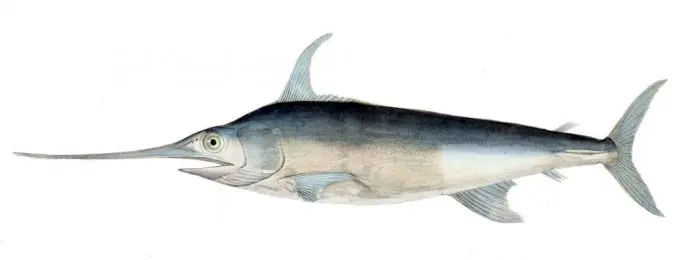
The swordfish is a strong fish characterized by an elongated, cylindrical body that tapers towards the tail. The upper jaw is elongated, turning into a plane at the end, in the form of a “spear” or “sword”, which is formed by the nasal and premaxillary bones. The lower oral jaw of the usual type is distinguished by the fact that it has no teeth. The eyes are characterized as large, and the gills are distinguished by a unique design. Gills are nothing more than modified plates, representing a single mesh plate, while there are no gill rakers as such.
Interesting fact! Fry and young individuals are characterized by the fact that they have cardinal differences compared to adult relatives. Similar differences concern both the scaly cover and morphology in general. After the fish grows up to 1 meter in length, changes in the shape of the body of the fish begin, and this process takes place gradually.
The swordfish has two dorsal fins, which are separated at some distance: the front fin, with a short base, is located immediately at the base of the head, and the rear fin, which is slightly smaller, is located almost at the very tail fin. There is also a pair of anal fins, which have rather soft rays. The pectoral fins are sickle-shaped and are located on the same projection as the dorsal fin. Swordfish do not have ventral fins. The caudal fin has a significant notch, which is why it has a month-shaped shape.
The dorsal region of the swordfish is darker and has a dark brown tint, and its belly is lighter and has a light brown tint, while the transition from darker to lighter is gradual. All fins are brown or light brown in varying degrees of brightness. Juveniles are characterized by the presence of stripes located across the body. As the fish grows, these stripes gradually disappear, as if washed away. Swordfish can grow in length to almost 5 meters, although the average size of individuals does not exceed 3 meters. In this case, the fish can gain weight up to half a ton.
Sword fish – rare shots
Behavior and lifestyle
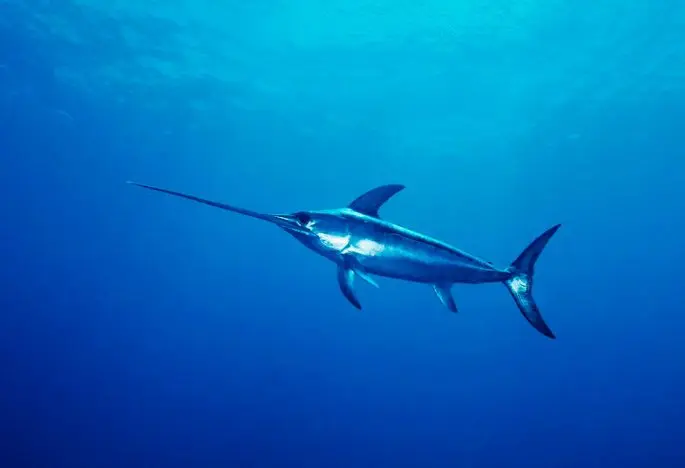
The swordfish is characterized as one of the fastest, because it can reach speeds in the water column up to 120 km / h, due to the special structure of its body. The presence of the same “sword” allows you to minimize the force of water resistance, and the torpedo-shaped body without scales improves hydrodynamic characteristics.
The swordfish also has a unique structure of gills, which represent not only the respiratory organs of the fish, but also a kind of jet-type engine. When a swordfish moves quickly, a stream of water constantly passes through and is ejected through the gills under pressure, while the fish can control the speed of this flow by constricting or expanding the gills.
Interesting to know! These fish make long migrations, but when there are no waves on the water surface, the fish rises almost to the very surface so that you can see its dorsal fin. At the same time, the swordfish sometimes accelerates and jumps out of the water, after which it falls back with noise.
A characteristic feature of the swordfish is its body temperature, which is almost a dozen and a half degrees higher than the temperature of the water. Thanks to these features, the swordfish is always in an active state and is able to immediately make a lightning throw, evading enemies or noticing its prey.
How long do swordfish live
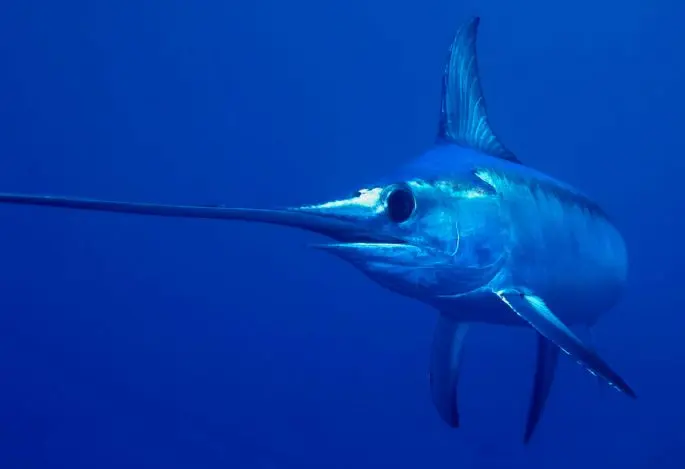
Female swordfish are not only larger than males, but also live longer. It is believed that on average these fish are able to live for about 10 years.
natural habitats
The habitat of swordfish extends to the waters of all the world’s oceans, as well as many seas, except for the Atlantic latitudes. They can be found in the Atlantic Ocean, within Newfoundland and Iceland, in the North and Mediterranean Seas, as well as in the coastal waters of the Black and Azov Seas. Commercial production of this fish is carried out in the Pacific, Indian and Atlantic Oceans, where quite numerous populations are observed even today.
Diet

Swordfish are fairly active predators that actively move in the water column, both in horizontal and vertical directions, descending to a depth of more than 700 meters. In connection with this feature, it is not difficult to assume that its diet is very diverse and consists of both small and large food objects that the predator comes across, both in the water column and at the bottom of reservoirs.
Important fact! The “sword” of swordfish serves as a kind of hunting tool, and the fish literally cuts its prey into pieces. In the stomachs of the caught fish, fragments of fish and squid were found, on which either traces of damage from the “sword” were found, or they were chopped into separate parts.
The diet of swordfish living in coastal waters and those individuals who prefer to live in the open waters of the seas and oceans are somewhat different. Fish that live in open waters mainly feed on cephalopods, while fish that live in coastal waters feed mainly on fish.
Reproduction and offspring
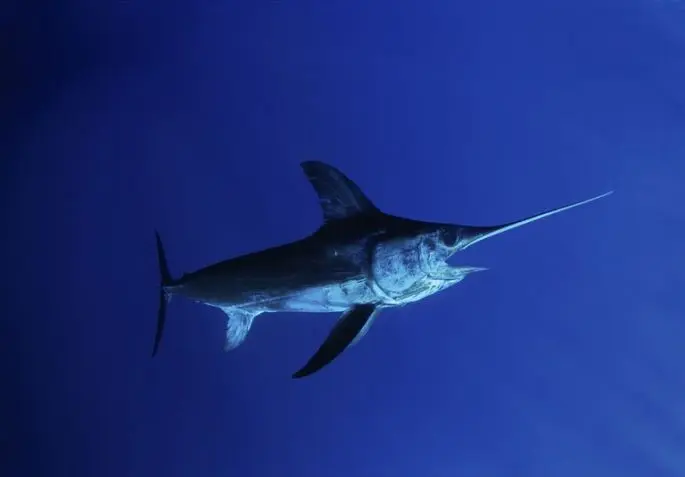
Unfortunately, to date, it is still unknown when and at what age the swordfish becomes sexually mature. This is most likely due to the fact that the fish lives in different conditions. It is known that spawning of fish occurs in the upper layers of water at a temperature of about +23 degrees. Depending on the habitat conditions, swordfish go to spawn at different times of the season. So, individuals living in equatorial waters can spawn year-round. Representatives of the Caribbean Sea and the Gulf of Mexico breed from April until almost September. Pacific representatives of the swordfish spawn in the spring and summer.
Swordfish caviar is not large, only 1,6-1,8 mm, while it is completely transparent and each caviar has a fairly large fat drop. It is believed that the swordfish is quite prolific. The fry that were born have a length of only 4 mm. The process of development and growth of this fish is accompanied by a long transformation. Since this process is long and continuous, it has no characteristic stages: we can say that this is one stage. The newly born swordfish fry have an almost colorless body covered with prickly scales and a short snout.
Important fact! Swordfish fry are born with a practically round head, without any points, and only in the process of growth and development do they develop a process in the form of a “sword”.
As they grow older, the jaws of juveniles lengthen, but still have the same size. After this, active growth of the upper jaw begins, as a result of which the upper jaw takes on the form of a “sword”. In young individuals, up to 25 cm long, one fin can be seen on the back, which occupies the entire back, as well as one anal fin and several rows of scales. Juveniles have a rather sinuous lateral line, and the jaws still have teeth.
With further maturation, the anterior part of the dorsal fin increases in height. When the swordfish grows up to 50 cm in length, the formation of the second dorsal fin begins, which is connected to the first. Upon reaching 1 meter in length, the scales disappear from the fish, as well as the teeth. At the same time, two dorsal and two anal fins are preserved, which are separated from each other.
Natural enemies of swordtails
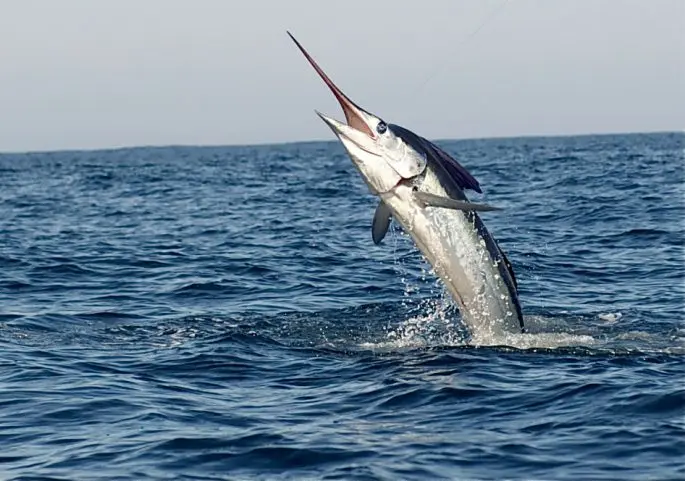
Adult swordfish have virtually no natural predators, although they are common prey for killer whales or sharks. Almost all predatory fish that live in the seas and oceans prey on young individuals.
A huge number of parasites were found in the body of swordfish, and almost all fish are infected, from its entrails to the skin.
Population and species status
In the water expanses of the world’s oceans, especially in recent times, there have been frequent cases of illegal fishing of this valuable fish. For this, special deep-sea networks are used. Eight years ago, Greenpeace put this fish on the list of seafood sold in stores in large quantities, which could lead to overfishing.
Swordfish in the Atlantic Ocean. Pulled out in 40 minutes!
Commercial value
Swordfish is a valuable and highly sought after fish in most parts of the world. This fish is actively caught on an industrial scale by more than thirty countries of the world.
In addition, swordfish are of great interest for sport and recreational trolling. The meat of the swordfish is white and tastes like pork meat. It can be cooked in a variety of ways, including frying, boiling, stewing, grilling, etc.
Important information! Mechenos meat is practically devoid of small bones, in addition, it is characterized as tasty. However, it does not have a characteristic fishy aroma.
Large catches of swordfish are observed in the eastern and northwestern waters of the Pacific Ocean, in the western waters of the Indian Ocean, in the Mediterranean Sea, as well as in the southwestern waters of the Atlantic Ocean. Swordfish are often caught in trawls as by-catch. Four years ago, a historical maximum of swordfish production was recorded, which amounted to almost 130 thousand tons.
Fascinating Facts About Swordfish
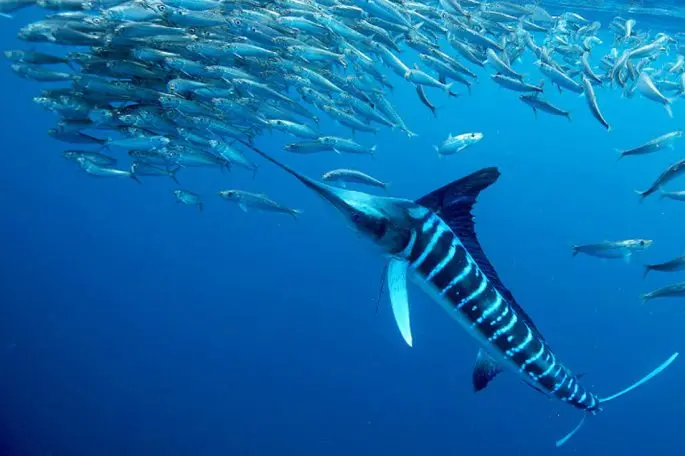
- The swordfish is distinguished by its enormous strength, high speed and endurance, therefore it represents the most dangerous predator of the world’s oceans.
- Often, swordsmen pierce ships and ships. Many claims this is because the fish are inherently aggressive, although some experts believe that fish confuse boats and ships with big fish.
- Swordfish often attack whales, although they do not eat their meat.
- Despite the fact that this fish is actively caught, experts do not worry about its future, since the fish is characterized as prolific.
- The aggressive nature of this fish was written in the works “The Old Man and the Sea” by E. Hemingway.
Useful properties and composition
Swordfish, like many other representatives of the oceans, is characterized by the presence of a large number of diverse and useful components. The energy value of meat is about 144 kcal per 100 grams of product, which is considered non-fat and suitable for preparing dietary meals. The biochemical composition of meat is characterized by the presence of many vitamins and minerals that are so necessary for the normal functioning of the human body. By eating swordfish meat, you can improve your physical and mental capabilities, optimize the functioning of all internal organs, and also protect the body from many external negative factors.
Swordfish in cooking

This fish belongs to the noble species, and its taste data is not inferior to such species as tuna, lobster or sea bass. The taste of swordfish meat is characterized as noble, thin and delicate, so the meat is considered a real delicacy. Often, fish is eaten raw, but it is important to know for sure that the fish is not infected with parasites. As a rule, this fish is very popular in those countries where it is actively caught, both on an industrial scale and by amateur anglers.
As it was said, it is permissible to cook this fish using various technologies, and one must always remember that the longer the fish is exposed to high temperatures, the less useful it becomes. As a rule, it is customary to fry fish, because it is fast and tasty, and especially its crispy crust. But here, too, there are pitfalls. Firstly, such a dish is not dietary, and secondly, it is even harmful, although quite tasty. Fried fish is especially contraindicated for people with poor gastrointestinal function.
So fried swordfish
To make the dish tasty, it should be prepared in a special way. It is important that the thickness of the pieces is not less than one and a half centimeters. It turns out that the thicker the steak, the tastier the dish, while its thickness should not exceed 3 cm.
First of all, you need to pour olive oil into the pan (sunflower oil is possible), after which the pan is heated to the desired temperature. The fish is cooked over high heat for about 10 minutes, while each side has 5 minutes. Salt and pepper each side before flipping. The steaks should fit freely in the pan so that they can be turned over with a spatula without any problems.
While the fish is fried, you can cut the lemon into pieces. After 10 minutes of frying, you can add a little butter and turn the fish from one side to the other. It is believed that this is a secret ingredient, although not required.
Putting the steak on a plate, it is immediately poured with balsamic vinegar. As a rule, fish is eaten without a side dish, but with lemon.
Swordfish with Garlic Potato









